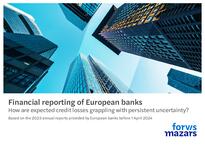We have analysed the 2023 year-end reports of 26 banks in 12 European countries to understand better the impact of financial turbulence and ongoing geopolitical crises on their Expected Credit Losses. This study is the eighth in its series and follows from previous editions of the report since its launch in 2020.
A focus on Expected Credit Losses
The study mainly focuses on the ECL-related impacts, with key findings on:
- ECL charge impact of YE 2023 on the profit or loss and ECL allowances
- ECL allowances: changes in coverage ratios and allocation between stages
- Post-model adjustments/overlays
- Forward-looking information
In the following, our Senior Manager Heike Hartenberger provides a contextualisation of the report for the German market:
The result of the current study at the international level is: "Credit institutions perceive their credit risk as decreasing, which is reflected in changes detected in several credit risk indicators for 2023. At the global level, no new significant overlay was reported in 2023. Most significant overlays continue to relate to uncertainties in the macroeconomic environment, including higher inflation and interest rates or difficulties in the property sector."
The development of credit risk is determined by macroeconomic scenarios in the broadest sense. It is expected that credit default risks will no longer result solely from borrower performance, but increasingly also from the loss in value of the collateral provided. Particularly high risks of loss have already been identified in 2023 in the area of commercial property, especially office property. In addition, the expected interest rate cuts will put increasing pressure on the interest margin and therefore on credit risk spreads. Another significant development that has also been observed in day-to-day practice since 2022 is the increase in the provision of collateral.








